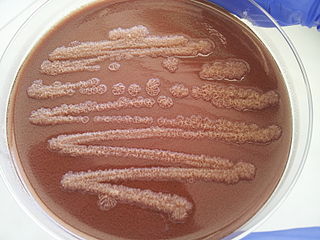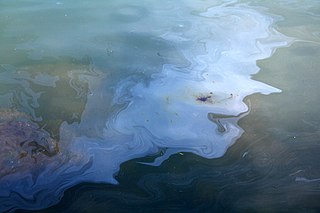Thermus thermophilus is a Gram-negative bacterium used in a range of biotechnological applications, including as a model organism for genetic manipulation, structural genomics, and systems biology. The bacterium is extremely thermophilic, with an optimal growth temperature of about 65 °C (149 °F). Thermus thermophilus was originally isolated from a thermal vent within a hot spring in Izu, Japan by Tairo Oshima and Kazutomo Imahori. The organism has also been found to be important in the degradation of organic materials in the thermogenic phase of composting. T. thermophilus is classified into several strains, of which HB8 and HB27 are the most commonly used in laboratory environments. Genome analyses of these strains were independently completed in 2004.
Pseudomonas citronellolis is a Gram-negative, bacillus bacterium that is used to study the mechanisms of pyruvate carboxylase. It was first isolated from forest soil, under pine trees, in northern Virginia, United States.
Pseudomonas mendocina is a Gram-negative environmental bacterium that can cause opportunistic infections, such as infective endocarditis and spondylodiscitis, although cases are very rare. It has potential use in bioremediation as it is able to degrade toluene. Based on 16S rRNA analysis, P. mendocina has been placed in the P. aeruginosa group.

Pseudomonas stutzeri is a Gram-negative soil bacterium that is motile, has a single polar flagellum, and is classified as bacillus, or rod-shaped. While this bacterium was first isolated from human spinal fluid, it has since been found in many different environments due to its various characteristics and metabolic capabilities. P. stutzeri is an opportunistic pathogen in clinical settings, although infections are rare. Based on 16S rRNA analysis, this bacterium has been placed in the P. stutzeri group, to which it lends its name.
Marinobacter hydrocarbonoclasticus is a species of bacteria found in sea water which are able to degrade hydrocarbons. The cells are rod-shaped and motile by means of a single polar flagellum.
"Aromatoleum" is a genus of bacteria capable of microbial biodegradation of organic pollutants. It has one single described species member, A. aromaticum, for which the only strain is strain EbN1.

Alcanivorax is a genus of alkane-degrading marine bacteria.
Alcanivorax borkumensis is an alkane-degrading marine bacterium which naturally propagates and becomes predominant in crude-oil-containing seawater when nitrogen and phosphorus nutrients are supplemented.
Gallaecimonas is a recently described genus of bacteria. The first described species of this genus was Gallaecimonas pentaromativorans gen. nov., sp. nov. isolated by Rodríguez Blanco et al. in 2010 from intertidal sediments of the ria of Corcubión. It is a Gram-negative, rod-shaped, halotolerant bacterium in the class Gammaproteobacteria. It can degrade high molecular mass polycyclic aromatic hydrocarbons of 4 and 5 rings. The 16S rRNA gene sequences of the type strain CEE_131(T) proved to be distantly related to those of Rheinheimera and Serratia. Its G+C content was 41.7 mol%.
Alcanivorax dieselolei is a species of alkane-degrading bacteria. Its genome has been sequenced. It is halophilic, aerobic, Gram-negative, non-spore-forming, catalase- and oxidase-positive, motile and rod-shaped. Its type strain is B-5T.
Novosphingobium pentaromativorans is a species of high-molecular-mass polycyclic aromatic hydrocarbon-degrading bacterium. It is Gram-negative, yellow-pigmented and halophilic. With type strain US6-1T. Its genome has been sequenced.
Thermoanaerobacterium aotearoense is a slightly acidophilic, anaerobic, thermophile first isolated from hot springs in New Zealand, hence its name. It is Gram-negative, peritrichously flagellated, rod-shaped forming oval terminal endospores. Strain JW/SL-NZ613T is its type strain. Its genome has been sequenced.
Brevibacillus borstelensis is a Gram-positive, aerobic, rod-shaped, endospore-forming bacterium of the genus Brevibacillus. The genome of several B. borstelensis strains have been sequenced.
Gordonia alkanivorans is a bacterium from the genus of Gordonia which has been isolated from soil which was contaminated with tar and phenol in Rositz in Germany. Gordonia alkanivorans has the ability to metabolize hexadecane. The strain RIPI90A of Gordonia alkanivorans can desulfurize dibenzothiophene.
Bowmanella is a bacteria genus from the family of Alteromonadaceae.
Olivibacter is a genus from the family of Sphingobacteriaceae.
Hydrocarboniphaga is a genus of bacteria from the family of Sinobacteraceae.
Alcanivorax mobilis is a Gram-negative, hydrocarbon-degrading and motile bacterium from the genus of Alcanivorax which has been isolated from deep-sea sediments from the Indian Ocean.
Akkermansia glycanphila is a species of intestinal mucin-degrading bacterium. It was first isolated from reticulated python feces in 2016.
Sphingobacterium olei is a Gram-stain-negative, rod-shaped, and non-motile bacterium. It was first isolated from oil-contaminated soil in Daqing oil field, China. S. olei has been found to be able to degrade herbicides quizalofop-p-ethyl and diclofop-methyl. Before a name was given, S. olei was designated as strain HAL-9T. The species name olei means "of oil" in Latin.

